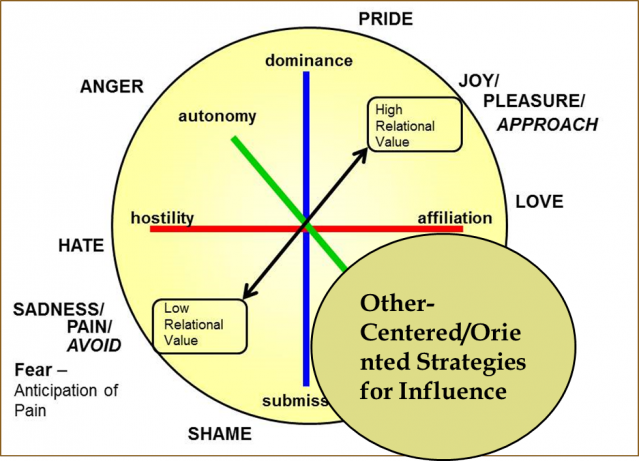Do you frequently think about the perspective and needs of others? Is it easy for you to be sympathetic to others' feelings? Do you seek approval, hate conflict, and fear criticism and rejection? Do you sometimes have trouble asserting your interests and desires? If you answered yes, then you may be high on other-orientation.
Our relational style is one of the most important features of our personality, and there are major differences in the extent to which people are self- or other-oriented. The goal of this blog is to help you understand the nature of this difference, clarify the elements that go into being other-oriented, and explain how being other-oriented is both valuable and creates emotional vulnerabilities.
Let’s start first by imagining people you know that vary in the extent to which they think about and care about others' perspectives. You should be able to identify people who fall along a spectrum here. Why? Because this dimension refers to one of the most studied and robust personality traits that psychologists have identified: It is a trait they call agreeableness. Agreeableness is one of the Big Five Personality Traits, and it refers to the extent that one tends to consider the perspective and feelings of another and acts accordingly. Thus, high agreeableness is largely synonymous with an other-orientation, whereas low agreeableness is associated with a more self-centered way of being. Here are three self-report items, that, according to Nettle (2007) are some of the best items for identifying an individual that is other-oriented (they are rated from very uncharacteristic of me to very characteristic of me):
- Making sure others are comfortable and happy.
- Insult others (negatively scored).
- Sympathizing with others.
Traits, which are descriptions of broad psychological dispositions, are useful, but they are also very “blunt” when it comes to understanding the dynamics of personality functioning. The dynamics of personality functioning refers to the specific ways a person adapts to the current environmental situation. For example, although I tend to be somewhat agreeable (a bit higher than average, but not super high), it is also (not surprisingly) the case that I can think of many situations when I have been very caring and sympathetic and other situations when I was not at all that way. Traits are not useful in explaining this within person difference. So how do we account for the more nuanced aspect of character functioning?
To get an understanding of this level of personality functioning, which is called the level of character adaptation, we need ways of understanding how perception, motivation, and emotion guide us in our social interactions. The model that I use to understand relational styles is called the Influence Matrix. It provides a framework for understanding both why people have broad dispositional tendencies (i.e., why people tend to be agreeable or not) AND it provides a map of the more fine-grained ways people have of adapting to specific social situations (i.e., why a person might be agreeable in some situations but less so in others).

The Matrix identifies the single most important variable in human relationships as being the variable of relational value (and social influence). That is the black line in the center. Relational value refers to the extent to which one is known and valued by important others and it is one of the most important needs we humans have (see here for a blog on RV).
The Matrix also maps three different “process” lines which relate to the ways people navigate relational value/social influence. They are social power (the blue line marked by the poles of dominance and submission), love (the red line marked by the poles of affiliation and hostility), and freedom (the green line marked by the poles of autonomy and dependency).
Now, what is particularly interesting about this diagram relative to the topic other-orientation is that the Matrix gives rise to two different quadrants, the upper left and lower right, which correspond well to the more specific elements of individuals who tend to be more self- or more other-oriented. So, look to the lower right and you can see if you can identify emotions and relational process variables that guide you highlighted there.

The first question to ask about yourself is the extent to which you seek relational value/social influence via affiliation. Affiliation means that you think about and internalize the interests of the other, and value working in cooperative and reciprocal ways. The question here is: Do you feel especially good when you are connecting with others, such as when you are sharing intimacies and engaging in pro-social behavior? This is the hallmark associated with this pole.
It is crucial to note that compassion, attraction and appreciation of the other are some of the most positive and hopeful aspects of being other-oriented. Indeed, many would argue that compassionate connection is the CENTRAL hope for a positive, just, and fulfilling world. As such, the positive side of being other-oriented is to be cherished; however, it is nevertheless a potentially vulnerable style, especially when it becomes an extreme, habitual way of being that overrides the capacity to effectively represent and defend one’s own self-interests.
Look at the other two poles in the lower right quadrant. The green pole is dependency. This refers to how much an individual needs approval and mirroring from another to feel secure. While some degree of dependency is both necessary and helpful in fostering meaningful relationships, extremes of dependency result in vulnerability to be taken advantage of, tendencies to hide how one feels to stay close to others, and diminished capacities for self-reliance. The other pole (bottom blue line) in the other-oriented quadrant is submissiveness. While we all need to submit at times, individuals who are extremely other-oriented will tend to submit at the slightest emergence of conflict. They will also often feel inferior and not uncommonly develop feelings of powerlessness and low self-esteem.
Examining the emotions on the outer circle reveals the primary affects that are related to being other-oriented. The first is “love”, which is meant very broadly here, and refers to the positive feelings associated with the joy of connecting with another in an affirming way. In addition to romantic and kin bonds, it also is meant to include friendship and other feelings of amity. Unfortunately, the other two feeling states associated with being other-oriented are shame (the feeling of weakness, inferiority) and guilt (the feeling of responsibility, fault and obligation to the other). While these “self-blaming” feelings are important to be capable of having, for the extreme other-oriented individual they can be easily activated and become chronically accessible, which is a recipe for a neurotic (anxious/depressive) pattern to develop.
Another important issue that the Matrix points to is that for many other-oriented people who are having difficulty in their relating to others, they will potentially experience feelings of resentment and bitterness about being not respected and taken advantage of. This sense will activate impulses and feelings delineated by the upper left of the Matrix, the self-oriented quadrant. That is, they will have urges to assert dominance, punish others for treating them poorly (hostility), or desire to distant themselves and become more self-reliant (autonomy). However, as these impulses emerge, they threaten the dependency and affiliative motives that have been such central guides in their lives. This inner conflict can result in the person feeling very anxious and confused, which in turn can contribute to a growing sense of emotional turmoil. (See here for a description of this conflict called an anger-guilt split).
The key from my perspective is to be aware of both the strengths and the vulnerabilities of being a giving, other-oriented person. As Adam Grant notes, being an effective giver is one of the most fulfilling ways of going through life. However, it is important also to realize that being an other-oriented person does carry vulnerabilities. As such, I will end with an example of a case I supervised, that of Jennifer (name and identifying information altered), which provides a narrative of how an other-oriented individual can experience relational and emotional difficulties. The goal is to help readers who might be having problems in this way see the connection between the relational style, relationships and negative feelings.
>>>
Jennifer was a 19-year-old college freshman who presented to the college counseling center with feelings of anxiety and depression. She reported that she grew up in a loving home, although probing revealed it was somewhat emotionally restricted. She reported her mother was quite protective of her, and it was a relationship that could be described as enmeshed. Jennifer described herself as sensitive, accommodating, and reported having a strong desire to be liked and accepted. She stated that she had a generally happy if somewhat sheltered childhood, but her mood and sense of security changed when she entered college.
The problems started with her roommate, who was both popular and somewhat dominating. Although they had initially gotten along fairly well, trouble emerged when her roommate started having her boyfriend stay over. This made Jennifer feel uncomfortable. She tried to state her feelings but was brushed off by her roommate. She told her mom about the situation, who became upset and told Jennifer she did not have to put up with it and that she should be more assertive. Jennifer again went to her roommate and made the request that the boyfriend not stay over, and in the course of the exchange she let it out that she had told her mother about it. Although her roommate stopped having her boyfriend stay over, she teased Jennifer, sometimes in front of their mutual friends, for running to her mother.
This incident had occurred two months prior to her entering therapy and had initiated a cascade of problems. She and her roommate now rarely spoke. Jennifer also felt her other friends looked at her negatively, and, consequently, she started feeling much more anxious, alone, and homesick. She also started having difficulty attending to her schoolwork, and she ended her first semester with Bs and Cs rather than As and Bs. This resulted in emerging doubts about her ability to succeed in college. When she came to therapy, she had started having trouble getting to sleep and getting out of bed in the morning. She had stopped attending one of the academic clubs she belonged to and was thinking about transferring to another school closer to home.
The therapy first focused on Jennifer learning to identify and accept her negative feeling states, without becoming overwhelmed or dysregulated by them. Next, we provided Jennifer with insight, derived in part from the map provided by the Matrix, so that she could understand what her relational style, needs, and habitual ways of responding were. She used that to recognize that she wanted to develop more capacities for self-reliance and wanted to be less dependent on the judgments and opinions of others. That transformed into her becoming very interested in her “identity” and she developed the desire to become the author of her own way of being, while still remaining authentic and connected with other people. For Jennifer, this became very freeing and she showed substantial improvements in overall self-concept, emotional stability, tolerance for negative feelings and ultimately, the depth and intimacy of her important relationships improved.




